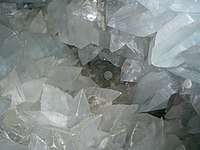Pulpí Geode
The Pulpí Geode (Spanish: Geoda de Pulpí) is a giant geode found in Spain near the town of Pulpí (Province of Almería) by Javier Garcia-Guinea of the Grupo Mineralogista de Madrid in December 1999. This geode is one of the largest documented geodes in the world to date. It occupies a space of 10.7 m3 (8 m long by 1.8 m wide by a 1.7 m average high) and is located at a depth of 50 m in the Pilar de Jaravía lead mine, in the Sierra del Aguilón, in the municipality of Pulpí, coinciding with the sea level, 3 km from the coast. It has a funnel shape, with the narrowest part being L-shaped. It is notable on a worldwide scale for both its size and the transparency and perfection of the selenite (gypsum) crystals lining the interior, which reach up to 2 m in length, with 0.5 m being the average.

Other large geodes include the Crystal Cave (Ohio), discovered in 1887 at the Heineman Winery on Put-In-Bay, Ohio.
External links
- The Pulpí gigantic geode (Almería, Spain): geology, metal pollution, microclimatology, and conservation
- Pilar de Jaravía; La geoda gigante de la Mina Rica (in Spanish)